FIBER TO THE HOME – A TRENCHLESS SOLUTION
Impact Moling
The global focus on the installation of fibre to the home (FTTH) is based on the commercial success of customers signing up for the service from providers. Therefore, the use of trenchless technology has been pivotal in not only increasing take up due to lack of disruption but also in reducing the heavy civil engineering cost elements associated with this work.
This article reviews the various trenchless techniques available to companies looking to maximize the effectiveness of installation.
The way that the ducting and fibre is installed will vary depending on many factors but mainly driven by the geography of the area. If you are planning work in an urban or rural aspect, the amount of existing buried infrastructure, if you are crossing a highway, river or rail road, if you are working in a field, desert or across a perfectly manicured lawn, the depth that the product can be installed in, the diameter of the duct and ground conditions will all play a factor in the final decision as to the most effective method to be employed.
As with all underground pipe or cable installations, open cut is an option and, in some cases, a viable one. Where streets are congested with infrastructure and there is a high risk of damage through strikes at the depth required or the run is of a very short, shallow nature then this may be the most effective method in those cases. However, in most situations the cost of traffic management, speed of installation, disruption to the public, liability of re-instatement and overall fiscal cost of open cut often makes alternative trenchless technology methods more practical, time saving and financially beneficial:
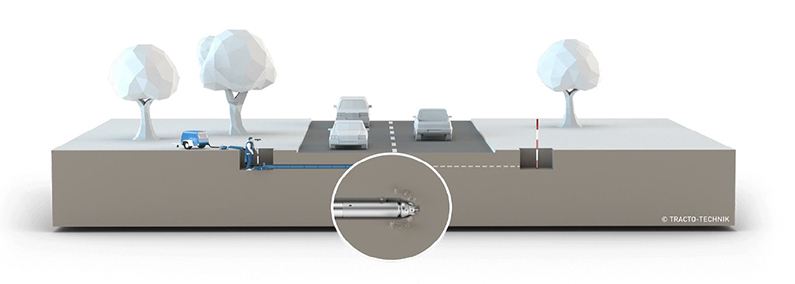
Impact moling is generally used for house connections or road crossings of up to 25m in length. Sizes range from 45mm up to 180mm although generally this is used for the smaller size of duct laying for fibre optic.
It is a free flight system that uses compressed air to drive a piston, hammering a new hole in the ground. The new duct or cable can then either be towed or pulled in for utilization.
A minimal crew compliment is needed to operate the equipment and training requirements are simpler than other techniques. Only small entry and exit pits are required for most projects. The tools can usually be fitted with different types of cones or heads for various soil conditions and can be fitted with a range of pipe and cable pulling adaptors to pull in product while boring.
This system, also called thrustboring, is widely used across the globe for these types of connections and is one of the most versatile forms of trenchless technology used for FTTH. In 2016 nearly 1,000 new moles were supplied in the USA for this purpose alone.
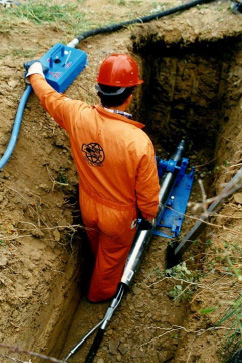
Stitching
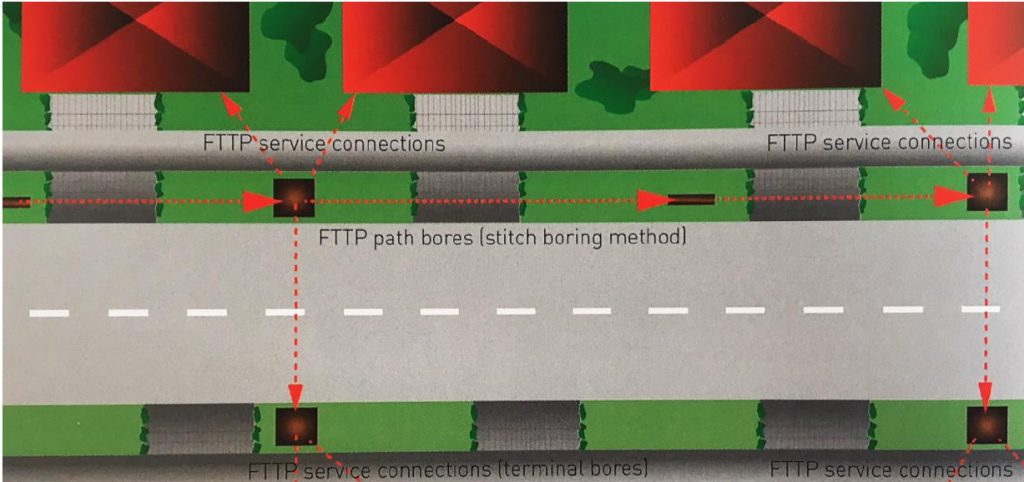
Stitching is an impact moling process that allows the installation of duct or cable over distances beyond that of a single bore – ie. Typically, 10–15m. It involves digging launch / reception pits at regular intervals over the total distance and launching, or ‘stitching’ the impact mole from pit to pit, eventually covering the total length of the required bore. This process is especially effective in prestigious private locations where it is not possible to get larger equipment, such as HDD in place but aesthetically poor excavation techniques are not desired.
Horizontal Directional Drilling
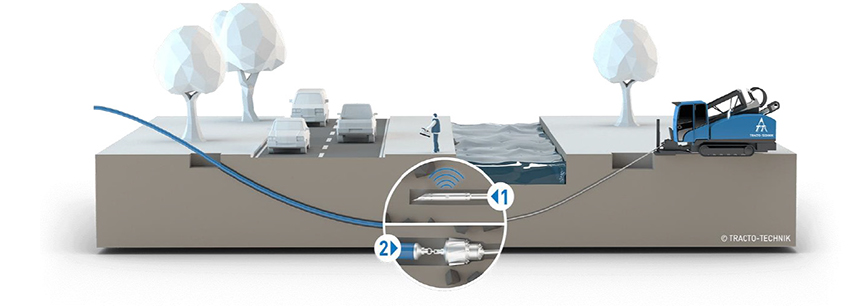
Directional Drilling can be broken down into two main areas of duct laying.
The first is for larger, or ‘midi’ range rigs to lay longer lengths for the ‘backbone’ and ‘last mile’ parts of the installation. Lengths can vary from just 15m up to several hundred metres and can be of any pipe or cable size up to 1m. This operation is usually done in advance of any house connection work.
The second use of HDD equipment is for the FTTH connection for shorter shots, often in limited space or commercially sensitive areas where open cut is not advantageous or cost effective and it is not possible to get larger equipment onto site. These rigs are often mounted on the back of a pickup truck and trailer and much more manoeuvrable. Bore distances are typically up to 100m and pipe sizes of 125mm are standard. This equipment allows longer shots of ducting to be done with minimal excavation and quicker than impact moling.
The cost of purchasing HDD equipment is much higher than the investment of impact moling equipment and the availability can also be an issue. Therefore, there is a ‘pivot’ point for each contractor where a decision on process needs to be made between stitching with an impact mole and using HDD.
Both applications of HDD rely on the same process and technology to operate but on different scales. Effectively a drill rig produces a certain amount of thrust and pull back force as well as torque on a string of rods to push them through the ground.
At the front of the drill stem is a location system (the ‘eyes’ for the head) and, in displaceable ground conditions an angled head where the face friction forces the drill stem in the required direction. In this way by continually rotating the drill stem and head the rods will move forwards in a straight line and by ceasing to rotate and just pushing at a particular angle – referred to by a clock face (12’o’clock to come up, 6 0’clock to go down etc.) allows the drill team to plot and bore to a pre-determined path, coming out at the required point. This process is referred to as the ‘pilot bore’ and once this is completed the drill head is removed from the drill stem and a reamer, or hole opener is fitted on. This is suited to the ground conditions encountered and the size of pipe being installed. Therefore it normally has a larger diameter than that of the required pipe by between 20% and 40%. This is then pulled back by pulling and rotating the drill stem using drill fluid to stabilize the bore and carry some of the bore cuttings out of the ground. The variation between ground being taken out and displaced varies depending on the conditions and make up.
Drilling in solid rock is also possible and requires specialist tooling to grind, or carve the rock into bits which is then carried out of the bore hole using suitable drill fluid. However, this process would be unusual for FTTH connections and is suitably covered as a technique elsewhere.
Mole Plowing
Mole plowing is using a blade to slice the ground open behind a tractor unit to either pull or feed a pipe or cable into the ground at the depth of the blade. This process can be used to install many hundreds of meters in a day very quickly but relies on the force of the tractor, suitable displaceable ground and is at most risk of striking other buried infrastructure due to the slicing method of the blade. It is most likely to be used in very rural areas such as fields. Multiple ducts can be installed with this method but the additional drag generated reduces the lengths per pull possible.

Trenching
This most general of techniques can be broken down into specific areas. Trenching is a process where a chain with teeth on is lowered into the ground using a tractor unit. The tractor unit can have various other attachments fitted to it. The chain, blade and teeth are specific to the ground conditions, depth and width of cut required and need to be changed for other sizes. The teeth include cups, for scooping displaceable ground such as clays and tips for grinding rock. This enables the equipment to open up a wide trench to a set depth and width. However, this is usually used on larger pipelines and not fiber optic laying but is still a cheap, effective but very disruptive way of placing ducting into the ground using minimal dig techniques.
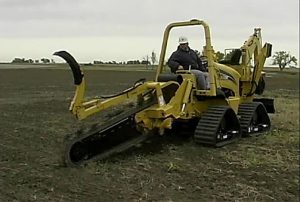
Narrow Trenching
Narrow trenching is a term used to cover trenching for small ducts in the range of around 50mm to 75mm. Because of the amount of ‘cut’ required this is often at shallower depths and therefore smaller, more versatile tractor units can be used which allows for productive trenching in semi-rural locations. These can also be used for private connections such as educational facilities, civil and military locations or commercial sites and often involve running a blade and chain attachment off skid-steer hydraulics or a small articulated tractor system.
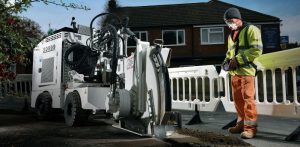
The process creates a ‘clean’ trench with the material removed to lay the ducting in the trench created. In this case usually either a 110mm duct or a multi-way ducting with minimal excavation techniques. The spoil can then be either re-used in the excavation or taken away to land fill and new material used. Often this size duct is laid at relatively shallow depths of around 450mm.
Micro-Trenching
Below 50mm and probably the most popular ‘trenching technique’ for fibre optic is micro-trenching. Many projects have been completed using this process, particularly in the United States of America. The process is the same as narrow trenching but allows for a smaller rock, or cutter wheel to cut a slot in a surface of anything up to 50mm in diameter down to depths of 300mm. In most instances this gives best results in urban situations where traffic management is light and long lengths in straight lines and consistent ground conditions are possible. It is usually laid between the curb and tarmac in a road surface. The system can be used in conjunction with a vacuum excavation system connected to the cutter wheel taking the dust and material from the cut reducing surface material and acting as a dust suppressant. By combining the tractor unit with the micro-trencher with a cable drum for the ducting and a highways approved fast setting resin this process can be continuous where regulation allows.
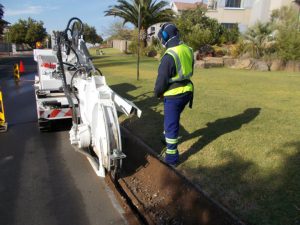
Although in an ideal situation it is possible to lay around 600m a day using this process it should be noted that any roadside obstructions such as parked cars and if working in footpaths obstructions such as trees, driveways requiring access as well as buried and surface infrastructure can impede progress. Similarly, we have seen a lot of examples in Western Europe where older cities with roads built up historically using different medium has presented productivity issues as well as the short, narrow and winding nature of many of these Roman or pre-Roman locations. Several trials are currently taking place to seek a way of improving this process under these conditions.
Cable Washover
As mentioned earlier in this paper some countries have ducting and copper cables placed in the ground previous projects. Due to the increase in buried infrastructure in some cases it can be advantageous to remove this old cable for recycling and utilize the existing bore path for newer fiber optic. In this case HDD can be used to bore out using a ‘wash over’ head to follow the line of the old ducting, reducing the friction enabling the old cable to be pulled out as a new duct line is pulled back. This process can be effective over longer distances and in chamber to chamber scenarios but is dependent on the age and condition of the old ducting and cabling to be good enough to prevent bore deviation.
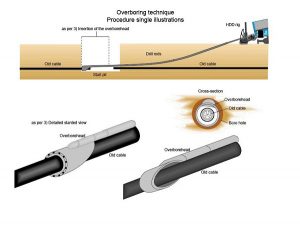
Keyhole
One of the most exciting areas of development for directional drilling and also the fibre market is the advancement of ‘keyhole’ operations. This allows for a house connection to be done from a 650mm core being cut in the surface, a chamber vacuum excavated to depth and a pit launched directional drill used to connect a house service up to 50m away, without anyone getting in the hole. The core can then either be simply replaced, or a chamber used. From one chamber several connections can be drilled, in a ‘spider’ system so that several houses can be connected using nothing more than a 650mm hole.

Cable Winches
In some cases a duct or the fiber line may be installed inside a sleeve. In these instances, cable pulling winches can be uses to pull in the duct or line directly. These can come in various different tonnages of pull and length of rope – up to 1,200m . They can also be equipped with speed or tonnage limiters and live data logging to ensure that the installation is within the manufacturer’s and client’s tolerances.
Cable Blowers
Cable Blowers are used to blow the strands of fiber optic cable several hundred meters inside the micro ducting for splicing and then connection to the property. Special coating on the inside of the micro ducting reduces friction as much as possible and straighter runs also increase the lengths possible. Depending on the size and power of the blower multi strands of fiber cable are also possible.
Cable Drum Trailers
These come in various sizes to accommodate a reel, or spool of either micro ducting or fiber cable to make dispersement and installation of the product easier. The range from drum trailers range from large hydraulically powered units capable of handling drum’s weighing several tons to small spool dispensers on micro-trenching units or even marker tape installers. The use of this equipment both reduces the working footprint and makes the handling of long lengths or cable or ducting easier. Many hundreds of meters or yards of product can be carried this way.
Conclusion
The installation of providing broadband or faster bandwidth is arguably overall the largest project underway globally. Each country has their own policy, agenda and method of operation to provide this. We have seen that there are many options open to contractors to install the ducting, micro-ducting, cable or fibre optic as required and that the driving factors for the method used are based on improving commercial take up, construction and reinstatement cost, speed of installation and homes passed per metre, access, infrastructure limitations, including other buried utilities and environmental issues.
The fibre optic roll out plan across the globe has a long way to go and will be with us for many years as the demand for and application of broadband increases and as technology invariably takes us forwards.
Trenchless technology has played and still has a significant part to play in this program, just as it has with gas, water and electricity, ensuring millions of people can stay in touch with each other, learn, shop, share information, assess data to make further discoveries or just upload their holiday pictures.
Source: Matthew Izard Paper Ref: #83 of Fiber To the Home – A trenchless Solution
